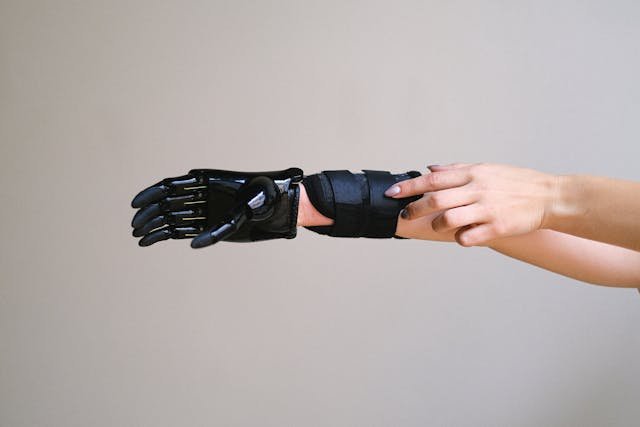For children with limb loss, prosthetic technology has come a long way. Traditional prosthetic limbs provided basic function, but they often required manual movement or harnesses that could feel unnatural. Now, myoelectric prosthetics are transforming the way children interact with the world, offering a level of control and independence that was once unimaginable.
Myoelectric prosthetics use electrical signals from muscles to move naturally, allowing kids to grip objects, play, and even perform delicate tasks with ease. These advanced prosthetics are not just improving movement—they are boosting confidence, self-reliance, and quality of life for children with limb differences.
In this guide, we’ll explore how myoelectric prosthetics work, their benefits, challenges, and how they are giving children greater freedom and confidence in everyday life.
What Are Myoelectric Prosthetics?
Myoelectric prosthetics are advanced bionic limbs that use muscle signals from the residual limb to control movement. Unlike traditional prosthetics, which rely on body-powered cables or manual adjustments, myoelectric arms and hands move in response to electrical impulses generated by muscle contractions.
Understanding How Myoelectric Prosthetics Work
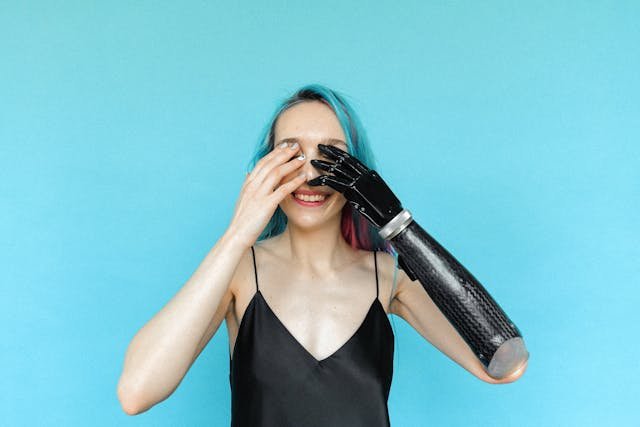
When a child thinks about moving their missing limb, muscles in the residual limb contract, producing electrical signals. These signals are detected by sensors (electrodes) placed inside the prosthetic socket. A small processor inside the prosthetic interprets these signals and sends commands to the prosthetic hand or fingers, allowing them to move in a smooth and natural way.
This advanced technology enables children to perform complex movements, such as gripping objects, turning door handles, and even holding delicate items like a pencil or a piece of paper.
Key Differences Between Myoelectric and Traditional Prosthetics
Traditional prosthetic limbs, especially body-powered prosthetics, require physical force from the shoulders or opposite arm to function. This can be tiring and may limit movement, especially for children who need to use their hands freely.
In contrast, myoelectric prosthetics offer:
- More natural movement – Kids can control their prosthetic limb just by thinking about the action.
- Increased comfort – No need for heavy harnesses or manual control.
- Greater independence – Allows kids to perform daily tasks with less effort and more precision.
Myoelectric technology is helping children use their prosthetic limb as a natural extension of their body, making it easier to engage in school, play, and everyday activities.
Who Can Use a Myoelectric Prosthetic?
Children with partial or complete limb loss in the arms or hands are the best candidates for myoelectric prosthetics. However, certain factors—such as muscle strength, nerve function, and prosthetic fit—play a role in determining if a child is ready for this type of prosthetic limb.
Most children adapt well to myoelectric technology with proper training and therapy. Early introduction to these prosthetics allows children to develop motor skills that will help them navigate daily life more efficiently.
Benefits of Myoelectric Prosthetics for Kids

One of the biggest advantages of myoelectric prosthetics is that they restore a more natural way of moving. Traditional prosthetics often require awkward or exaggerated movements, but myoelectric arms mimic how a real hand or arm moves.
Restoring Natural Movement and Function
Children can perform tasks such as:
- Picking up and holding small objects.
- Writing, drawing, or using a touchscreen.
- Eating independently with utensils.
By allowing finer control over grip strength and wrist rotation, myoelectric limbs help children perform daily activities with ease, reducing frustration and making movement feel more intuitive.
Boosting Confidence and Emotional Well-Being
Children with limb loss may sometimes feel self-conscious about using a prosthetic limb, especially if it looks unnatural or is difficult to control. Myoelectric prosthetics, with their sleek, high-tech design and natural movement, help children feel more comfortable and confident in their abilities.
With a myoelectric limb, children can:
- Participate in social activities without feeling different.
- Play games and interact with their friends without struggling to keep up.
- Gain a stronger sense of independence, knowing they can manage daily tasks on their own.
Confidence is just as important as physical ability, and giving children a prosthetic limb that moves naturally helps them feel more in control of their own lives.
Encouraging Skill Development and Adaptability

Using a myoelectric prosthetic requires learning and practice, which helps children develop problem-solving skills and adaptability. Prosthetic training teaches kids:
- How to fine-tune their muscle signals to improve control.
- How to adjust grip strength based on different tasks.
- How to incorporate their prosthetic into daily routines seamlessly.
These skills make it easier for children to adapt to new situations and become more self-reliant, preparing them for school, sports, and other daily activities.
Challenges and Considerations of Myoelectric Prosthetics
Unlike basic prosthetics, myoelectric limbs require training to use effectively. Since they rely on muscle signals, children need to learn how to activate the right muscles to perform different movements.
Learning Curve and Training Requirements
Training may include:
- Working with a prosthetist or occupational therapist to build muscle strength.
- Practicing specific exercises to improve grip control.
- Learning how to care for and maintain the prosthetic limb.
With consistent practice, most children quickly adapt to using their myoelectric prosthetic with ease.
Battery Life and Maintenance
Myoelectric prosthetics run on rechargeable batteries, which need regular charging and proper care. If the battery runs out, the prosthetic will lose its ability to move, so teaching children and parents how to manage battery life is crucial.
Additionally, like any advanced technology, routine maintenance and occasional repairs may be required to keep the prosthetic functioning properly.
Cost and Accessibility
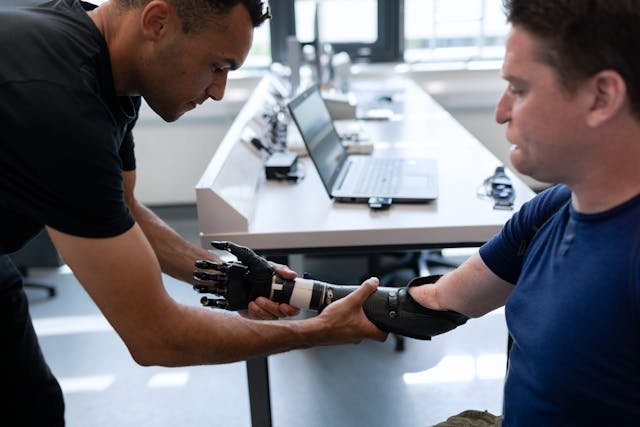
Myoelectric prosthetics are more expensive than traditional options, and not all insurance providers fully cover them. However, organizations and funding programs are working to make these advanced prosthetics more affordable for children in need.
Parents should explore:
- Government disability aid programs.
- CSR and charitable organizations that provide financial support.
- Health insurance options that offer partial or full prosthetic coverage.
As technology becomes more widespread, myoelectric prosthetics are becoming more accessible, allowing more children to benefit from this life-changing innovation.
The Future of Myoelectric Prosthetics for Kids
Advances in Prosthetic Technology
Prosthetic technology is evolving rapidly, and future myoelectric limbs will be even more advanced. Some upcoming innovations include:
- Lighter and more responsive designs for easier movement.
- AI-powered prosthetics that adapt to a child’s movement patterns.
- Sensory feedback systems that allow children to feel pressure and texture.
These advancements will make prosthetic limbs even more intuitive, allowing children to interact with their environment in new and exciting ways.
More Inclusive and Affordable Solutions
As myoelectric prosthetics become more common, they are also becoming more affordable and widely available. Efforts are being made to:
- Reduce production costs through 3D printing and advanced materials.
- Create custom prosthetics tailored to individual needs.
- Develop new training programs to help children adapt faster.
These improvements will give more children access to high-quality prosthetics, ensuring they can move, play, and explore freely.
Real-Life Success Stories of Children Using Myoelectric Prosthetics
For many children with limb loss, everyday tasks like brushing teeth, tying shoelaces, or holding a pencil can be challenging with traditional prosthetics. However, myoelectric limbs provide a higher level of functionality, allowing children to complete these tasks on their own, without assistance.
Regaining Independence in Daily Activities
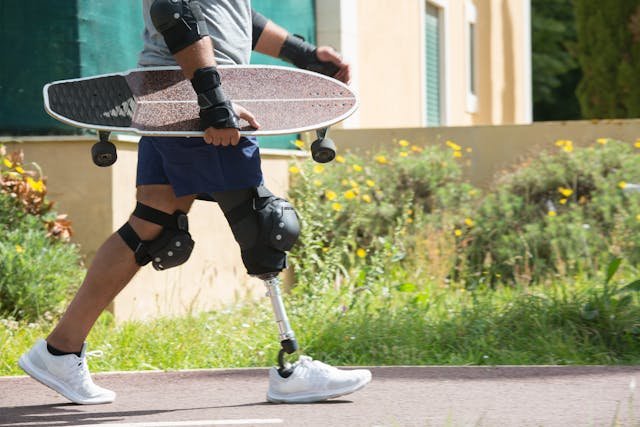
One inspiring example is an 8-year-old girl in India who lost her right arm in an accident. Before receiving a myoelectric prosthetic, she needed help with basic tasks like dressing and eating. After just a few months of using her new bionic hand, she could hold a spoon, grip a water bottle, and even draw without difficulty. Her newfound independence gave her a sense of confidence and normalcy, allowing her to focus on school and play.
Stories like this demonstrate how technology is not just restoring mobility—it’s giving children the ability to take control of their own lives.
Playing Sports and Engaging in Physical Activities
Many children with limb differences dream of participating in sports, dancing, or outdoor games with their friends. Myoelectric prosthetics are helping these dreams come true by providing greater mobility and grip control.
A young boy who was born without his left arm struggled to play cricket and football, two of his favorite sports. With a traditional prosthetic, he found it difficult to hold a bat or control the ball. After receiving a custom myoelectric hand, he was able to grip a bat properly, catch the ball, and play with his friends without limitations.
These stories highlight how myoelectric prosthetics are removing barriers and ensuring that children can participate fully in sports, hobbies, and other physical activities.
Boosting Social Confidence and Emotional Well-Being
For some children, the biggest impact of a myoelectric prosthetic is not just physical—it’s emotional.
A 12-year-old boy who used a traditional prosthetic arm often felt self-conscious about his appearance and avoided social situations. His old prosthetic did not move naturally, making him feel different from his classmates. After switching to a sleek, responsive myoelectric limb, he felt more confident and comfortable in social settings. He no longer hesitated to raise his hand in class, shake hands with new friends, or take part in school activities.
This emotional boost is just as important as physical function. When children feel confident in their prosthetic, they can interact more freely, build friendships, and embrace their full potential.
The Importance of Early Prosthetic Training and Adaptation
The sooner a child starts using a myoelectric prosthetic limb, the easier it is for them to adapt. Early introduction allows:
Why Early Introduction to Myoelectric Prosthetics Matters
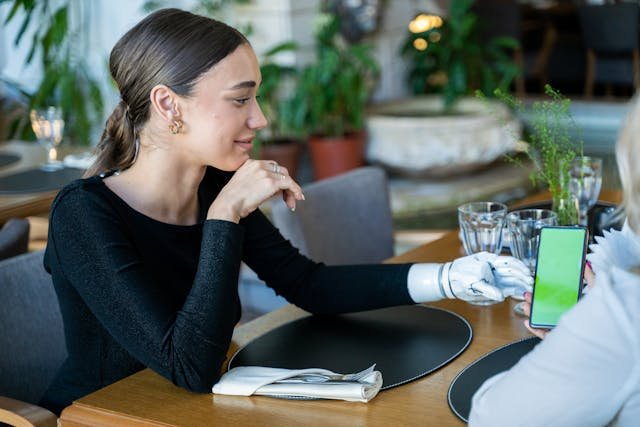
- Better muscle memory development, as children learn how to control their prosthetic using natural movements.
- Stronger brain-prosthetic coordination, ensuring that the limb becomes a seamless part of their daily life.
- Faster emotional acceptance, preventing self-consciousness or hesitation later on.
When children begin prosthetic training at a young age, they have more time to master fine motor skills and develop confidence in using their new limb.
Key Training Techniques for Myoelectric Prosthetic Users
To ensure a smooth transition, children should participate in structured prosthetic training that includes:
- Muscle activation exercises to strengthen the residual limb and improve electrode response.
- Object manipulation tasks to enhance grip control, such as picking up small objects or using different hand positions.
- Daily practice with real-life tasks, like holding utensils, writing, and opening doors.
Occupational therapy sessions can help children learn to control their prosthetic limb with precision, ensuring they can complete tasks with ease and confidence.
Encouraging a Positive Mindset During Training
For some children, learning to use a prosthetic limb can feel frustrating at first. They may struggle with muscle control, coordination, or movement timing. Encouraging a growth mindset is essential—reminding them that learning takes time and effort.
Parents and therapists can support children by:
- Celebrating small wins, such as successfully gripping an object for the first time.
- Using fun challenges or games to make training more enjoyable.
- Providing reassurance and encouragement to boost their confidence.
With the right support, children can quickly adapt to their myoelectric prosthetic limb and embrace new possibilities.
How Families and Communities Can Support Children with Myoelectric Prosthetics
Parents and siblings play a major role in helping children adjust to their myoelectric prosthetic limb. A supportive home environment should focus on:
Creating an Inclusive and Supportive Home Environment
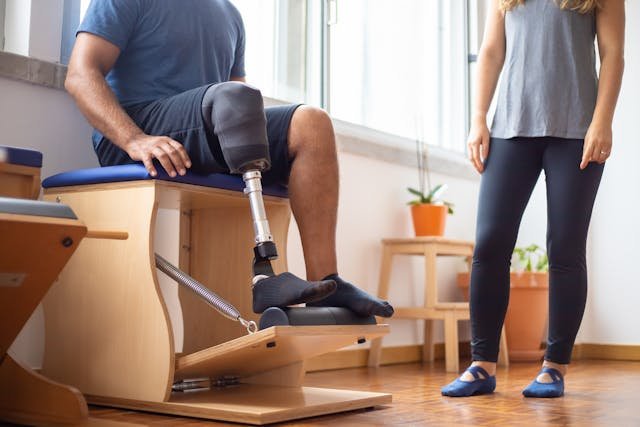
- Encouraging independence, allowing children to try tasks on their own before offering help.
- Normalizing the prosthetic, treating it as a natural part of life rather than something “different.”
- Engaging in shared activities, such as playing games or doing exercises together, to build confidence and skill.
The more comfortable and empowered a child feels at home, the more confident they will be in public, school, and social settings.
Supporting Inclusion in Schools and Social Settings
Children with prosthetic limbs should feel fully included in school activities. Teachers, classmates, and school administrators can help by:
- Educating peers about myoelectric prosthetics, reducing curiosity-driven questions and promoting understanding.
- Ensuring accessibility in the classroom, such as providing adaptive tools or modified activities.
- Encouraging participation in sports, arts, and extracurricular activities, so children feel like an equal part of the community.
When schools foster an inclusive and welcoming environment, children with prosthetic limbs can focus on learning, making friends, and enjoying their education without hesitation.
Connecting with Other Families and Support Networks
Joining a community of other children and families who use prosthetic limbs can be incredibly helpful. Support groups and peer connections allow children to:
- See other kids using myoelectric prosthetics, which boosts confidence.
- Share tips and experiences, learning from others who have gone through similar challenges.
- Find mentorship and inspiration, especially from older children or adults who use advanced prosthetic technology.
These connections help children feel less alone in their journey, ensuring they have the emotional and social support they need.
Final Thoughts: A Brighter Future for Kids with Myoelectric Prosthetics
Myoelectric prosthetics are changing the way children with limb loss experience the world. By restoring natural movement, boosting confidence, and promoting independence, these advanced limbs empower kids to live life without limits.
At Robobionics, we are committed to providing cutting-edge, custom-fit prosthetic solutions that help children move with freedom and confidence. If your child needs a high-quality, myoelectric prosthetic, contact us today to explore the best options available.



